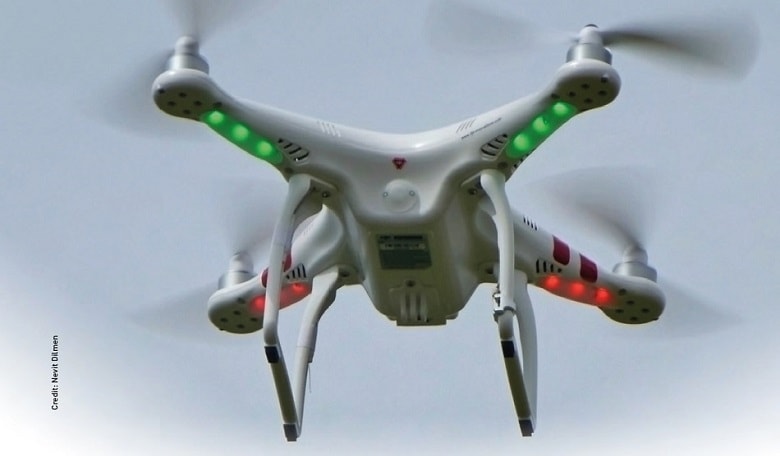An Unmanned Aircraft System (UAS), colloquially known as a “drone”, is basically an aerial robot. The flight of a UAS can be remotely controlled, like a regular radio control aircraft (Remotely Piloted Aircraft Systems or RPAS). A UAS can also fly fully-autonomously, with the flight controlled by sensors, GPS, and on-board computers performing as a sophisticated autopilot. UASs include airplanes, helicopters, quadcopters and blimps, and some can be flown indoors.
The first UAS were military. However, the civil market is burgeoning and the technology is advancing fast. UAS weights range from a few hundred grams to a ton.
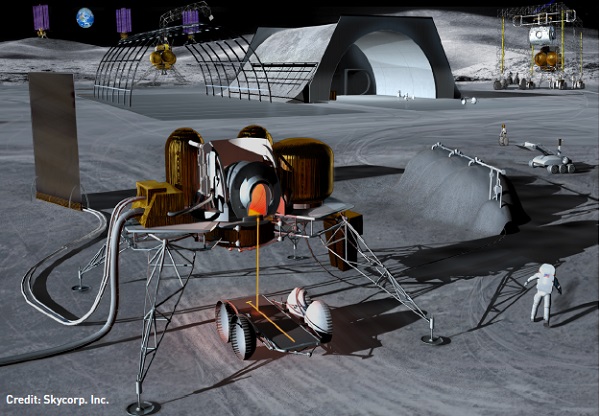 In 2013, the DHL parcel service tested a drone for delivering medicine.
In 2013, the DHL parcel service tested a drone for delivering medicine.
Europe sees the emergence of civil applications of Unmanned Aircraft (UA) or Remotely Piloted Aircraft Systems (RPAS) as a source of economic growth and jobs. In March 2015, during the Riga conference1, Europe took a decisive step towards the future of aviation with a roadmap to support RPAS services and manufacturing, promoting industrial competitiveness and development of SMEs2. Back in 2013, the UAS Roundup3 was reporting that the US and Israel were the largest manufacturers because of their long history of military RPAS development. However, in the near term, large RPAS with a cost in the range of millions of euros are likely to be unaffordable except for large institutions. At the other end of the spectrum, for €200, any technician or specialist in model airplanes4 can manufacture a home-made flying vehicle with a cross structure, 4 engines, 4 propellers, a GPS sensor, a flight control system and a digital map.
Additionally, it is even possible to automatically program these flying machines by using and adapting open source software such as MultiWii5, Pixhawk6, OpenPilot7, Dronecode8 or DIYdrones forum9. Alternatively, a leisure user can buy a quadcopter for around €300. With €1000, a small estate agent can buy an RPAS which carries a Go-Pro camera and begin filming the streets where he sells properties from the air10. Now, not only are offthe- shelf models becoming cheaper, but they are being joined by an increasing number of specialised devices. Finally, the manufacturing of drones could also lead to another revolution: “some are working on base stations armed with 3D printers intended to service drones from any manufacturer.”8
One could imagine a drone controlled from an iPad or a smart phone and produced using 3D printing. Electric propulsion is already quite often used in drones. In May 2015, NASA announced having successfully flown a remotely piloted aircraft powered by 10 electric motors that can take off vertically, then rotate its wing and tail surfaces and fly like an airplane11. This drone makes use of distributed propulsion, an interesting feature of electric propulsion.
Drone flight
In recent years, European companies have increased the use of drones to provide business to consumer (B2C) or business to business (B2B) services.
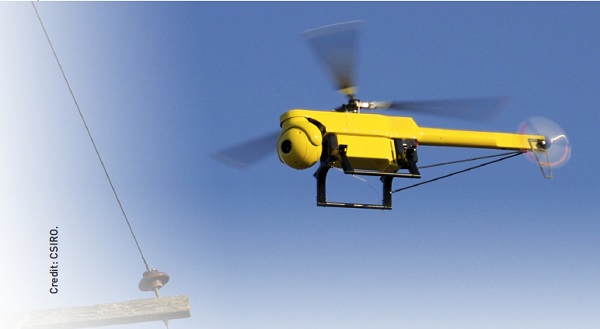 Unmanned aerial vehicles (UAVs) offer a cost-effective way of inspecting powerlines, bridges, buildings, and cooling towers. CSIRO researchers are developing technology that will allow UAVs to safely and reliably perform such tasks with only minimal guidance from a ground-based operator.
Unmanned aerial vehicles (UAVs) offer a cost-effective way of inspecting powerlines, bridges, buildings, and cooling towers. CSIRO researchers are developing technology that will allow UAVs to safely and reliably perform such tasks with only minimal guidance from a ground-based operator.
Between January and October 2014, the number of organisations permitted by the UK’s Civil Aviation Authority (CAA) to fly drones under 20kg rose by 80%.8 In France, the number of approved drone operators has risen from 86 in 2012 to 431 in 2014.12 Currently, Europe has over 1000 drone operators. In the USA, drones are in use counting sea lions in Alaska, monitoring drug trafficking across borders and conducting weather and environmental research. In fact, 327 operators to date are licensed by the Federal Aviation Administration to fly over U.S. soil.13 2013 was a record year for venture investment in drones in the USA, with a reported $79 million in 15 deals, including some by marquee investors such as Google Ventures and Andreessen Horowitz.14
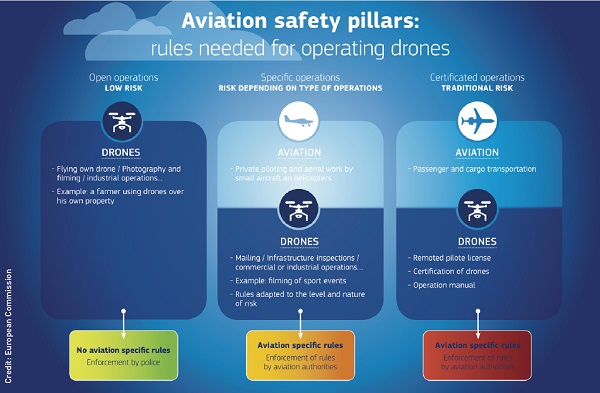 Drones can be used for so many things that a complete yet flexible set of rules and regulations will be required.
Drones can be used for so many things that a complete yet flexible set of rules and regulations will be required.
The use of RPAS technology already spans over several different domains such as filming, aerial photography for surveys, monitoring of crops, forest management, firefighting monitoring, or particularly heavenly wedding photographs. Some companies like Delair-Tech15 create added value niche products with small, long-range drones capable of providing pipeline surveillance and operating beyond line of sight (BVLOS). In 2012, they got the first certification for BVLOS flights. Danish Aviation Systems16 are experts in drones for agriculture, land surveying, mining and research. They have developed the first drone for firefighters in Denmark with both HD and infrared. Ascending Technologies17 offers an advanced multicopter for professional aerial imaging in full-HD quality.
This thriving market, the variety of technical platforms, the proliferation of amateurs and the increase of professional usage are the first challenge faced by the regulator which has been mandated to support the drone market while ensuring that no safety risks are overlooked.
Drones come with other baggage: many citizens are outraged by the military’s use of UASs and fear terrorist attacks using drones as weapons. The use of unmanned aerial vehicles (UAVs) in war and counterterrorism operations remains a controversial issue at international level.
Europe sees the emergence of civil applications of Unmanned Aircraft (UA) or Remotely Piloted Aircraft Systems (RPAS) as a source of economic growth and jobs.
Drones burst into the public consciousness during the wars in Iraq and Afghanistan. The European Parliament (EP) has initiated the discussion and urges the active promotion of transparency, accountability and the rule of law in relation to the use of drones. Members of the European Parliament (MEPs) have called for an EP resolution18 on this topic in order to push forward the debate at the European level.19 Additionally, citizens’ concerns for safety and social aspects (e.g. liability, insurance, privacy and data protection, security) have to be addressed. This is the second challenge for regulations which should reconcile innovation and simplification of administrative burden with risk control for safety and social acceptance.
At the same time, new advanced services supported by drones are being developed. There are several major organisations considering parcel deliveries by RPAS. Amazon has been authorised to carry out tests by the FAA in the United States with RPAS operated by remote pilots.20 Amazon is also testing this Prime Air concept in the United Kingdom and Israel, and is planning testing in multiple international locations. The RPAS are used to autonomously fly individual 5 pounds or less packages to destination.
Google is also developing a concept originally meant to deliver defibrillators in cities. Their drone is a tail sitter that drops the payload using a sort of winch and therefore does not land. They are testing in a remote area of Australia. The vehicles are pre-programmed and fly to their destination automatically.
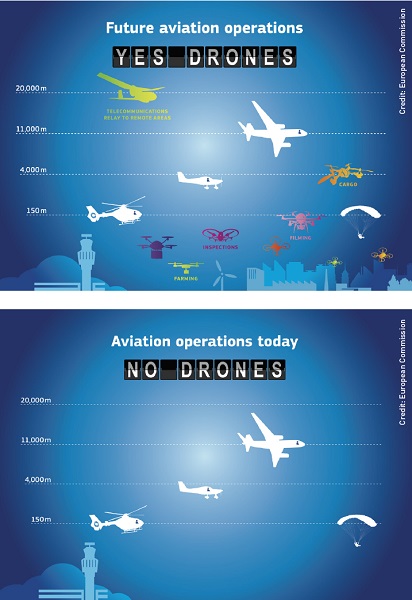 Drones will operate at many different altitudes depending upon their function.
Drones will operate at many different altitudes depending upon their function.
DHL parcelcopter is a research programme supported by the German local and federal governments to explore the feasibility of the concept. They fly BVLOS in a reserved flight corridor between the coast and one island to deliver medications. The flights are constantly monitored so that manual action can be taken immediately and the pilots are in contact with Air Traffic Control. The Swiss post will test the delivery of parcels in remote villages. These tests will use Matternet RPAS and will be performed in collaboration with the cargo division of Swiss International Air Lines.21
The Swiss federal Institute of Technology is considering a project to use RPAS in Africa to deliver goods using pre-determined routes that would be geo-fenced. The French Postal Services have successfully flown a 6-rotor drone over a distance of 1200m carrying a 2kg parcel over a test range in the south of France. The flight was entirely automatic. This experiment supports the use of drones to carry parcels in remote areas (islands, mountainous area). The RPAS manufacturer Matternet is envisaging to use quadcopters to deliver medicines and other high values goods in places without road access. They have tested in Haiti, Bhutan, the Dominican Republic, and Papua New Guinea. In the latter, flights were made to pre-determined landing areas where someone had to be present. Issues revealed by these experiments are the batteries, autonomy and the sensitivity of the drone to heavy rain. The drone manufacturer Matternet anticipates that drones will revolutionise small-package delivery, where the so-called last mile of the delivery cycle accounts for 70% of the cost.8
It is expected that deliveries of goods or medication will be first in remote areas as operations in urban areas are posing significant challenges. A further challenge will be passengercarrying drones: the first emergency evacuation of a wounded person was performed very recently.
This is the third challenge to design regulations for drones. New services provided by drones are likely to emerge or to change when writing such regulations. So, how do we avoid early obsolescence of the regulations?
Consolidating apparently contradictory aims seems like trying to square the circle. Maybe, these challenges can actually be the driver to the solution? Europe already benefits from field experience with drones’ operations authorised by national regulations. Technology of RPAS can evolve rapidly in some widespread domains such as flight path monitoring and telecommunications’ protocols. At the same time, other specialised areas like affordable, embedded light-weight solutions for ‘detect and avoid’ for medium size RPAS still need research.
The starting step is the definition of a proposed concept of operations,22 which sets the baseline for the subsequent regulation. The operations are categorised into a comprehensive regulatory umbrella covering all RPAS uses and services. The objective is to guarantee minimum certainty, uniformity, and predictability for the European market thus creating a stable legal environment. In order to deal with changes, inventions, and discoveries, flexibility is accommodated by a classification of the operations according to their risk.
The concept of operations establishes a high-level classification of ‘Open’, ‘Specific’ and ‘Certified’ operations with increasing performance requirements based on the associated risk and required competency of an operation.
With the ‘Open’ category, a small start-up company or amateur can start low-risk, lowaltitude operations under minimal rules but with constraining limitations such as for example operations under visual line of sight and outside of specified reserved areas (e.g. restrictions arising from airport, environmental protection, security). Aviation authorities are not involved. For pipeline monitoring (requiring beyond visual line of sight operation), the limitations of the ‘Open’ category would not reduce the risk to a tolerable level. This kind of operation would typically fall under the ‘Specific’ category.
The ‘Specific’ category requires the operator to perform a safety risk assessment of the planned mission and to identify mitigation measures. Mitigation means can involve safety systems or specific conditions like for example protection of airspace during operations. The national aviation authority reviews and approves the safety case through an operations authorisation. The authorisation indicates the specific conditions and limitations for the intended operation. It can be issued to authorise a single event or a series of operations under specified conditions. The ‘Specific’ category places the emphasis on organisations (particularly operators). Safety culture and proper safety management must be promoted.
Finally, higher-risk operations such as RPAS operations coexisting with manned aircraft in nonsegregated airspace fall into the ‘Certified’ category. These operations and the RPAS involved therein follow the standard aviation process.
Cat’s cradle
This engineering and legislative ‘cat’s cradle’ will be properly untangled once industry delivers the technical standards and products for specific RPAS equipment including autopilots, data link systems, Remote Pilot Stations, Detect and Avoid systems, and Flight Termination Systems. Miniaturisation is an additional limiting factor to the sustainability of light RPAS operations.
The French Postal Services have successfully flown a 6-rotor drone over a distance of 1200m carrying a 2kg parcel over a test range in the south of France. The flight was entirely automatic.
Drones are clearly a top priority for the EU and for the European Aviation Safety Agency. The concept of operations will be consulted upon in summer so that a final version can be presented to the Commission at the end of the year. This concept of operation must be performance based to allow the sustainable development of drones.
Guidelines for the open category will also be consulted upon in summer with the objective of presenting a final version to the Commission at the end of the year. The Agency is facing a tight agenda and many challenges but this is a great opportunity. It is committed to working in close coordination with JARUS23 and ICAO to ensure worldwide harmonisation
References:
1: http://ec.europa.eu/transport/modes/air/news/doc/2015-03-06- drones/2015-03-06-riga-declaration-drones.pdf
2: Small and medium-sized enterprises
3: http://www.aerospaceamerica.org/Documents/AerospaceAmerica- PDFs-2013/July-August-2013/UASRoundup2013t-AA-Jul-Aug2013.pdf
4: Challenge, N°431, 30 April 2015, Drones: la menace fantome
5: http://code.google.com/p/multiwii/
6: https://pixhawk.ethz.ch/software/start
7: https://www.openpilot.org/ & http://www.openpilot.org/serious- UAS-uses/
8: https://www.dronecode.org/ & http://www.theguardian.com/ world/2014/oct/26/drones-permit-uk-british-airline-pilotsassociation- unmanned-aircraft-house-of-lords
9: http://diydrones.com/profiles/blog/show?id=705844:BlogPost:17789
10: BBC, Game of drones: As prices plummet drones are taking off, by Padraig Belton, Technology reporter, 16 January 2015
11: http://www.avweb.com/avwebflash/news/NASA-Flies-10-Engine- Electric-Drone-224035-1.html
12: What The U.S. Can Learn From Europe’s Growing Commercial Drone Industry, Posted Apr 25, 2015 by Michael Dahmen
13: http://droneproject.nationalsecurityzone.org/uncertainties-remainas- faa-integrates-drones-into-american-skies-josh-solomon/
14: San Jose Mercury News Business, Look up: The commercial drone market is about to take off, by Patrick May, posted 03/01/2014
15: http://www.delair-tech.com/delair-tech/the-company/
16: http://www.danishaviationsystems.dk/
17: http://www.asctec.de/en/UAS-uas-drone-applications/aerialinspection- aerial-monitoring/
18: Cf. Joint motion for a resolution on the use of armed drones (2014/2567(RSP)), http://www.europarl.europa.eu/sides/ getDoc.do?pubRef=-//EP//TEXT+MOTION+P7-RC-2014- 0201+0+DOC+XML+V0//EN
19: European Parliamentary Research Service, http://epthinktank.eu/
20: Liberation, 23rd of March 2015, N°10526, Etats-Unis: Amazon autorise a tester la livraison par drones
21: Le Figaro, 20th of April 2015, N°21989, La Poste suisse va tester des drones de livraison
22: http://ec.europa.eu/transport/modes/air/news/doc/2015-03-06- drones/2015-03-06-riga-declaration-drones.pdf
23: JARUS (Joint Authorities for Rulemaking on Unmanned Systems) is a cooperative body of around 32 countries worldwide providing a forum for harmonisation of rules on drones





